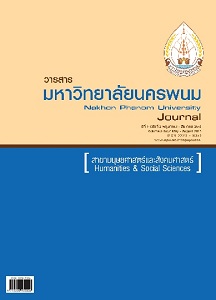โมเดลสมการโครงสร้างเชิงเส้นของความสำเร็จสำหรับสถานศึกษาขั้นพื้นฐาน
Main Article Content
Abstract
การวิจัยครั้งนี้มีวัตถุประสงค์เพื่อ 1)ศึกษาอิทธิพลทางตรง อิทธิพลทางอ้อม และอิทธิพลรวมของปัจจัยเชิงสาเหตุที่ส่งผลต่อ ความสำเร็จของสถานศึกษาขั้นพื้นฐาน และ 2)ตรวจสอบความสอดคล้องของโมเดลสมการโครงสร้างเชิงเส้นของความสำเร็จสำหรับ สถานศึกษาขั้นพื้นฐานที่ผู้วิจัยพัฒนาขึ้นกับข้อมูลเชิงประจักษ์ กลุ่มตัวอย่างเป็นผู้บริหารสถานศึกษา ขั้นพื้นฐานระดับมัธยมศึกษา สังกัด สำนักงานคณะกรรมการการศึกษาขั้นพื้นฐาน จำนวน 400คน ที่ได้มาโดยวิธีการสุ่มแบบหลายขั้นตอน เครื่องมือที่ใช้ในการเก็บ รวบรวมข้อมูลเป็นแบบสอบถาม จำนวน 70 ข้อ มีค่าความเชื่อมั่น 0.91 มีค่าจำแนกรายข้อระหว่าง 0.38-0.77 และมีความเที่ยงตรง เชิงโครงสร้าง สถิติที่ใช้วิเคราะห์ข้อมูล ได้แก่ สถิติพื้นฐาน การวิเคราะห์องค์ประกอบเชิงยืนยัน และการวิเคราะห์โมเดลสมการโครงสร้าง
ผลการวิจัยพบว่า 1)สถานการณ์ที่เกี่ยวข้องมีอิทธิพลทางอ้อมและอิทธิพลรวมสูงสุดต่อความสำเร็จของสถานศึกษาขั้นพื้นฐาน เท่ากับ 0.93 รองลงมาคือ ภาวะผู้นำการเปลี่ยนแปลงของผู้บริหารสถานศึกษามีอิทธิพลทางตรงและอิทธิพลรวมเท่ากับ 0.73 แรงจูงใจ ของผู้บริหารสถานศึกษามีอิทธิพลทางอ้อมและอิทธิพลรวมเท่ากับ 0.33 และคุณลักษณะของผู้บริหารสถานศึกษามีอิทธิพลรวมเท่ากับ 0.32 ต่อความสำเร็จของสถานศึกษาขั้นพื้นฐาน โดยสัดส่วนของความเชื่อถือได้ของปัจจัยเชิงสาเหตุที่อธิบายความสำเร็จของสถานศึกษา ขั้นพื้นฐานได้ร้อยละ 69.00และ 2)โมเดลสมการโครงสร้างเชิงเส้นของความสำเร็จสำหรับสถานศึกษาขั้นพื้นฐานที่ผู้วิจัยพัฒนาขึ้น มีความสอดคล้องกับข้อมูลเชิงประจักษ์ ( x2 = 86.92, d f = 96, P-value = 0.74, GFI = 0.98, AGFI = 0.95, CFI = 1.00, SRMR = 0.02, RMSEA = 0.00, CN = 621.17)
The objectives of this study were: 1) to investigate the direct, indirect, and overall influences of causal factors affecting the success of basic education institutions, and 2) to examine goodness-of-fit between the linear structural equation model of success for basic education institutions developed by the researcher and the empirical data. A sample was 400 secondary school administrators under Office of the Basic Education Commission as selected by multi-stage random sampling. The instrument used to collect data was a 70-item questionnaire which had a reliability coefficient of 0.91, discrimination power values ranging from 0.38 to 0.77 and construct validity. Statistics used to analyze data included fundamental ones, confirmatory factor analysis and structural equation model analysis.
The findings of the study were as follows: 1) the concerned situation estimated its highest indirect and overall influence on success of basic education institutions as 0.93. Secondary were: transformational leadership of school administrators which estimated its direct and overall influence as 0.73, motivation of school administrators which estimated its indirect and overall influence as 0.33, and the characteristic of school administrators which estimated its overall influence on success of basic education institutions as 0.32. The proportion of reliability of causal factors could explain 69.00% of the success of basic education institutions. 2) The linear structural equation model of success for basic education institutions developed by the researcher had goodness-of-fit with the empirical data (x2 =86.92, df=96, P-value=0.74, GFI=0.98, AGFI=0.95, CFI=1.00, SRMR=0.02, RMSEA=0.00, CN=621.17).


